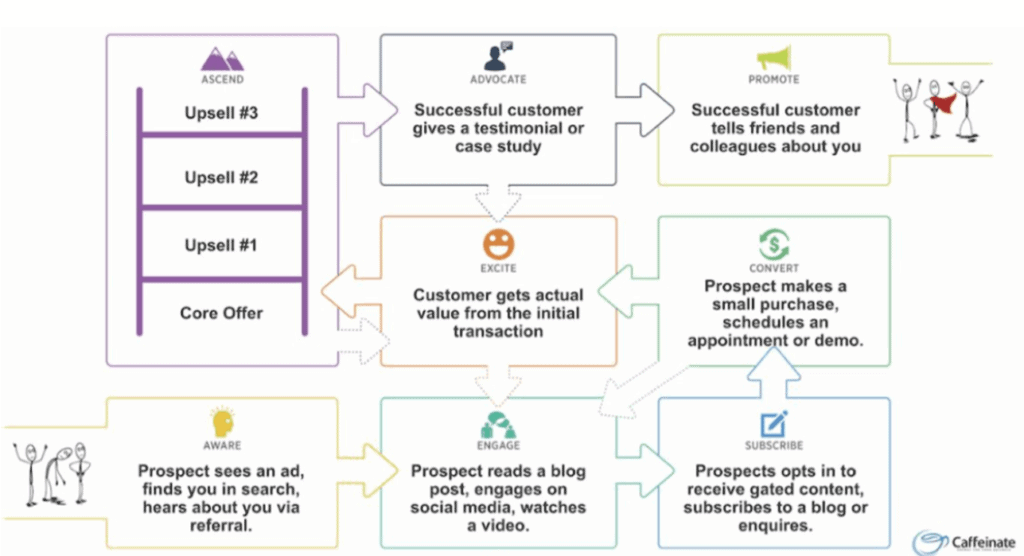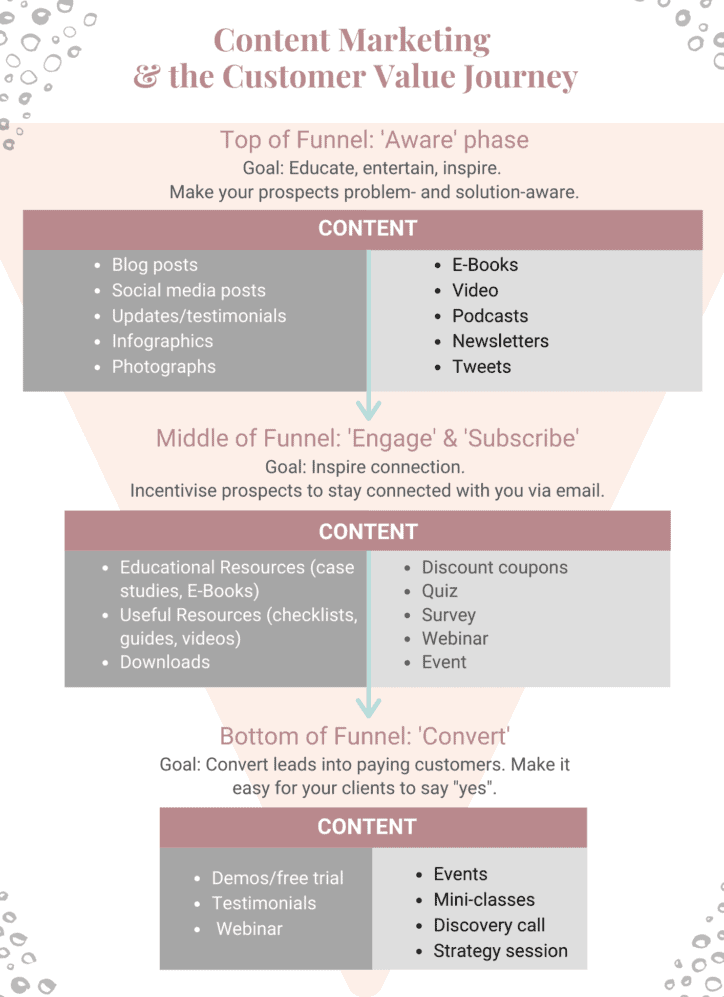Do you need more clients? More leads or sales?
If so, it’s likely you need to optimise your Customer Value Journey.
One of the biggest mistakes most businesses make is they’re walking around trying to sleep with complete strangers.
– Sabri Suby
This might sound harsh, but metaphorically it’s very true.
Has this happened to you before?
You go to a lot of trouble to create a great product or service offering that delivers value and transformational results for your client, and you’re super excited to put it out to the market. So you send your great offer out to your email list and post it all across your social media channels multiple times. And then you wait with bated breath for the clients to start rolling in.
Except all you hear is … crickets.
If that’s happened to you before, you’re not alone. It’s a very common problem that first-time business owners encounter. And it’s completely normal that no one responds to your offer if you haven’t yet taken the time to move your leads and prospects through a powerful Customer Value Journey.
In this article, we’re going to explain to you what the Customer Value Journey is and why you need one.
What is a Customer Value Journey?
A Customer Value Journey is a step-by-step process that attracts and converts prospects into paying clients and keeps them coming back. It’s an invaluable digital marketing tool that helps business owners improve their conversions, their sales, and their Return on Investment (ROI).
A Customer Value Journey is an invaluable digital marketing tool that helps business owners improve their conversions, their sales, and their Return on Investment (ROI)
Marketing and selling are all about building relationships, and people only buy from people they know, like, and trust.
Marketing and selling are all about building relationships, and people only buy from people they know, like, and trust. #salestips #smallbiztips Share on XWhen was the last time you bought something from someone who you don’t know or trust? I’m guessing you’re like the rest of us, and you’ve never done that.
It takes time to build a relationship and there are roughly eight different stages.
You know how it goes when you meet someone you like. You might first invite them for a coffee, and if that goes well you might invite them out for dinner, and if that goes well you might do that a few more times before inviting them back to your place, and so on.
If you were to invite someone back to your place before you even know them, that would be creepy!
You need to build the relationship slowly. And the exact same is true for marketing. You need to give people time to get to know, like, and trust you before you start asking them to buy from you.
The diagram below shows the eight different stages of a human relationship, which coincides with the eight different stages of the customer value journey in marketing.

Both are a process of building a relationship naturally and organically. If you try to skip a step, it feels weird for everyone involved.
So How do You Apply this to Your Marketing?
You’ll need to provide different types of content during each different phase of the customer value journey with the intention to move them one step further along.
Below is an overview of how you might apply the different steps to your marketing strategy (courtesy of Caffeinate Digital).

Phase-Relevant Content Types
Here are the different stages and the different types of content you can use to organically move prospects along the customer value journey. The content is divided into ‘top of funnel’ strategies, ‘middle of funnel’ strategies, and ‘bottom of funnel’ strategies.

The 8 Stages of the Customer Value Journey
Now let’s look at the eight different stages of the Customer Value Journey in detail (adapted from Digital Marketer’s Customer Value Journey).
Step 1: Make Your Prospects Aware
The first step is to make your customers aware that you exist and that they have a problem that you can solve. During this phase, you’re simply educating, entertaining, and inspiring your audience. It’s all about giving value with no strings attached. You’re not asking them to spend any time or money with you, you’re simply giving lots of value for free.
In terms of human relationships, this is like the ‘romancing’ phase (see Figure 1).
The types of content to offer during this phase include blog posts, free events, social media posts, podcasts, video, etc (see Figure 3).
Step 2: Get Your Prospects to Engage
According to the Merriam-Webster dictionary, engagement is defined as “emotional involvement or commitment”. During this phase, you’re still continuing to show up and offer great value with no strings attached, because your prospects are still trying to figure out if they know, like, and trust you. If they’re liking what they see so far, you’ll see your prospects engaging with your posts and your content, either through clicks, comments or shares. They’re starting to trust you.
If you can prove your value during this phase (by giving lots of great value), then they’re more likely to want to spend time or money with you, which comes during the ‘subscribe’ phase (next).
Your goal in this phase is to keep giving great value and informing your audience about how you solve the different challenges they may have so they’ll feel more compelled to get involved with you and your brand.
Step 3: Ask Them to Subscribe
As Digital Marketer says: “When someone likes their experience with your brand, trust begins to build. Once that happens, it’s time to ask for a small commitment – subscribing – and giving you permission to email them.”
In this phase, you offer them a lead magnet (something of high value that they can download for free), in exchange for their contact details. This allows you to continue marketing to them via email, further nurturing the relationship with them, and further building trust and confidence in your brand.
You offer something they want, they fill out a form to get it. It’s that simple.
There’s just one problem. Today, people are careful about giving out their email addresses. You have to offer something valuable that makes it worth their while. Think webinars, free samples of a product or chapters of a book, demos, reports, and guides.
You offer something they want, they fill out a form to get it.
It’s that simple.
Step 4: ‘Convert’ – Make Them a Customer
As the team at Digital Marketer says: “If your free offers have enough value (answering questions and solving problems), your prospects are often eager to deepen their commitment. They just need to know how.”
The best way to do that is through an entry-point offer—a high-value, low-risk offer that lets them sample your wares without putting too much skin in the game.
To be clear, an entry-point offer is not designed to make you a profit. Its only purpose is to create a smooth transition from subscriber or follower to a paying customer. You can focus on profits later in the customer value journey.
Now, in this phase, you only need to ask for a small commitment: say, $8–$20. Your goal is simply to cover your costs in acquiring the customer.
Step 5: Get Them Excited About Your Brand
This is all about creating memorable experiences for your new customers.
As Digital Marketer says:
Buying generates warm fuzzies. It’s a scientific fact.
Buying generates warm fuzzies. It’s a scientific fact. The dopamine from a new purchase gets people excited—which is why the fifth stage of the Customer Journey is to build on that excitement.
How do you do that? By giving your new customer a memorable experience.
Consider offering a quick-start guide… bonus features that surprise and delight… quick wins… any content that makes your new customers happy.
Step 6: ‘Brand Advocate’ – Turn Your Customers into Multi-Buyers
At this stage, your goal is to generate repeat buys and real profits. While your entry-point offer was designed for conversions, your ‘ascension’ phase offers should be geared for profits—because if you’re serving your customers well, they’ll want to buy again and again. Your ‘ascension’ ladder is how you can upsell your existing customers from your core offer into higher ticket items with you.
As a general rule of thumb, the profit margin increases with every upsell you generate, because you have no cost to acquire the customer. They’re already a brand fan and advocate.
As a general rule of thumb, the profit margin increases with every upsell you generate, because you have no cost to acquire the customer.
Ascension offers may be simple upsells made after that initial purchase… bigger, better solutions… or “done for you” add-ons.
Step 7: ‘Referrals’ – Ask Them to Spread the Love
Happy customers love to share their experiences, but sometimes they need some encouragement to do so. The cool thing is, once they do, they become even more loyal to your brand.
Happy customers love to share their experience…
So, at this stage of the Customer Value Journey, ask people to share their positive experience with your brand by writing a review, by sending referrals your way, or sharing social media posts with their audience.
Step 8: ‘Promote’ – Make Them a Promoter
Up until now, any “promotion” your customers have done has been passive. But in the promotion stage, your customers actively spread the word about your brands, products, and services. They tell stories, make recommendations, and share your offers because they truly believe in them.
Active promotion may be an affiliate or commission relationship—or just a free offer for sending some new customers your way. The point is, it’s a win-win for both of you.

How to Help People on Their Journey
Digital marketing is about helping customers move along this journey faster. That’s why you can’t use just one tactic or an ongoing series of unfocused marketing campaigns.
You need a plan that addresses every stage of the Journey. And you need to think in terms of optimising that journey.
___________________
Did you like this article? Let us know in the comments below xx
And if you’d like to learn more about optimising your customer journey, why not work with one of our coaches.
You can book a call with one of our Fempire Coaches right now!

This was written by one of our talented team members. Head to our About Fempire page to learn more about what Fempire does and how you can join the sisterhood. And don’t forget to follow us on Facebook, Instagram, LinkedIn, Youtube, or Pinterest by clicking the buttons below.




0 Comments